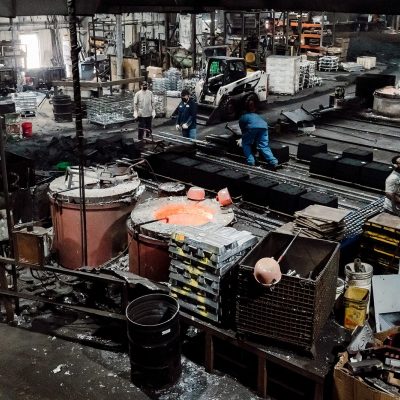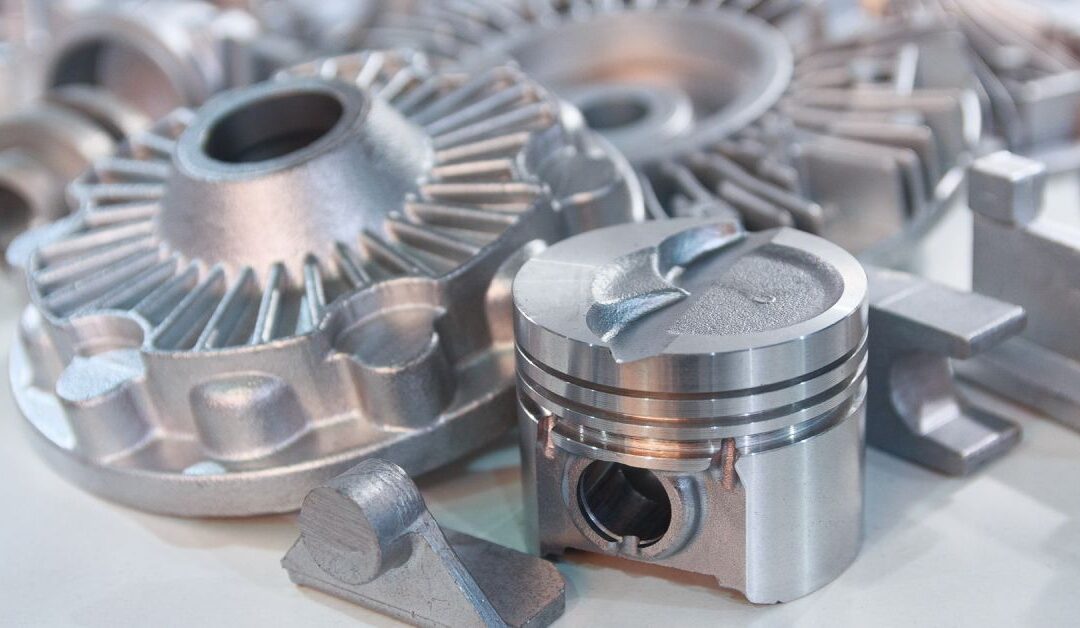How Aluminum Castings contribute to durable industrial components
Wiki Article
Comprehending the Metal Castings Process: A Comprehensive Guide for Beginners
The Metal Casting process is a fundamental technique in manufacturing that changes molten metal into strong kinds. Novices should comprehend the numerous approaches entailed, such as sand casting and pass away casting. Recognizing the products, style concepts, and safety and security steps is similarly essential. Each aspect plays an important role in attaining effective end results. As one navigates these details, the concern of how to maximize each step for improved outcomes becomes progressively significant.The Essentials of Metal Casting
Although Metal Casting has progressed over centuries, its essential concepts stay indispensable and constant to the production process. At its core, Metal Casting involves the makeover of molten steel right into strong items via different methods. The process starts with the development of a mold, which specifies the form of the last product. Once the mold and mildew is prepared, metal is heated up to its melting factor and put right into the cavity. After cooling, the metal strengthens, taking the form of the mold and mildew.There are several casting approaches, including sand casting, investment casting, and pass away casting, each with one-of-a-kind advantages and applications. The choice of technique depends on variables such as manufacturing volume, material type, and wanted precision. When cast, the last item might undergo extra procedures like machining or surface treatment to achieve the called for coating and specs. Comprehending these fundamentals is essential for anybody thinking about the area of Metal Casting.

Comprehending Products Used in Steel Casting
Products play an important role in the Metal Casting process, influencing the final item's residential properties and efficiency. Various steels are utilized, including aluminum, iron, bronze, and steel, each offering unique characteristics matched for particular applications. Light weight aluminum is lightweight and corrosion-resistant, making it optimal for automobile components. Iron, particularly cast iron, is preferred for its outstanding wear resistance and durability. Steel supplies high toughness and versatility, usually used in heavy machinery elements. Bronze, recognized for its deterioration resistance and machinability, is typically used in marine applications.In enhancement to the steels, different casting products, such as sand, plaster, and ceramic, are made use of to develop mold and mildews. Sand spreading, one of the most prevalent technique, makes use of silica sand because of its thermal security and capability to create elaborate shapes. Plaster and ceramic mold and mildews use better details but may call for more complex procedures. The choice of materials directly affects the performance, price, and high quality of the spreading operation.
The Style Process: From Concept to Plan
The layout procedure in Metal Casting begins with the initial concept growth, where ideas are produced and examined. This is followed by the application of CAD modeling techniques, permitting accurate visualizations of the style. Lastly, the blueprint finalization steps guarantee that all requirements are accurately documented for manufacturing.Preliminary Principle Advancement
Initial principle growth notes a vital phase in the Metal Casting process, where concepts transform into tangible layouts. Throughout this stage, developers collaborate with engineers and stakeholders to brainstorm and improve preliminary principles. They take into consideration elements such as capability, aesthetic appeals, and manufacturability, ensuring that the layout satisfies the called for specs and efficiency criteria. Sketches and harsh drafts are produced to visualize the concepts, enabling initial evaluations of usefulness and cost-effectiveness. This stage additionally involves determining materials and prospective casting methods that straighten with the design objectives. Inevitably, initial idea development prepares for a complete plan, directing the subsequent stages of the spreading procedure and guaranteeing a successful shift from idea to fact.CAD Modeling Techniques
Transforming principles into exact layouts, CAD modeling techniques play an essential role in the Metal Casting process. These strategies make use of sophisticated software application to produce thorough three-dimensional models that properly reflect the desired product. By utilizing devices such as parametric modeling, strong modeling, and surface modeling, developers can manipulate dimensions and shapes easily. CAD systems additionally facilitate simulation and analysis, permitting the identification of prospective problems prior to production begins. This positive method reduces product waste and optimizes the design for manufacturability. Additionally, CAD models can be easily modified, allowing quick iterations based on comments. Fundamentally, CAD modeling functions as the backbone of the layout procedure, linking the space between initial ideas and the eventual production-ready styles.Blueprint Finalization Tips
Adhering to the development of thorough CAD models, the next stage entails plan finalization, which is essential in converting electronic layouts into actionable prepare for manufacturing. This process begins with examining the CAD models for accuracy and conformity with requirements. Once validated, the measurements, resistances, and product requirements are diligently outlined to guarantee quality. Integrating notes and annotations helps communicate crucial details relating to casting procedures, surface coatings, and setting up requirements. The completed plan undertakes an extensive approval procedure, typically including partnership with engineers and manufacturing teams to attend to any kind of possible problems. Nevertheless modifications are made and approvals acquired, the blueprint is officially launched, acting as the fundamental file for the subsequent phases of Metal Casting, including pattern making and mold and mildew layout.The Steel Casting Techniques Described

Metal Casting techniques include a range of approaches used to form molten metal right into wanted forms. These methods differ according to the kind of product, intricacy of the design, and manufacturing volume. Sand casting is among one of the most typical approaches, involving the production of a mold and mildew from sand to hold the molten steel. Financial investment casting, or lost-wax casting, enables intricate designs by utilizing a wax pattern that is disappeared. Pass away casting employs high-pressure shot of liquified steel into a mold, ideal for mass manufacturing. Various other techniques include irreversible mold and mildew spreading, which uses recyclable mold and mildews, and centrifugal spreading, where rotational pressures assist in filling up the mold. Each method has its benefits and applications, making it essential for suppliers to pick the ideal approach based upon their specific demands and requirements. Understanding these strategies is crucial for any person associated with the Metal Casting process.
Finishing Processes: Enhancing Your Casted Item

Finishing processes play an important role in enhancing the quality and look of casted products. Numerous surface area therapy strategies, such as polishing and covering, are used to enhance resilience and aesthetic appeals. Additionally, high quality examination techniques guarantee that the final product satisfies specified requirements and efficiency requirements.
Surface Therapy Methods
A variety of surface area therapy techniques play a crucial function in improving the quality and longevity of casted items. These techniques consist of approaches such as shot blasting, polishing, and finishing. Shot blowing up properly removes surface flaws, boosting the aesthetic and practical features of the casting. Sprucing up provides a smooth finish, which is especially important for decorative applications and components requiring minimal rubbing. Finish techniques, such as electroplating or powder coating, deal added defense versus corrosion and wear, guaranteeing resilience. Additionally, surface therapies can improve attachment for succeeding processes, such as painting or bonding. By using these approaches, manufacturers can accomplish premium surface top quality, which is essential for the performance and life-span of Metal Casting in different applications.Top Quality Evaluation Techniques
Reliable top quality evaluation techniques are vital for ensuring the stability and efficiency of casted items after the finishing procedures. Numerous techniques are utilized to assess the top quality of Metal Casting, consisting try these out of visual evaluation, dimensional checks, and non-destructive screening (NDT) Aesthetic examination allows for the identification of surface area problems, while dimensional checks assure that items satisfy defined tolerances. NDT methods, such as ultrasonic testing and radiographic assessment, supply deeper understandings into internal integrity without harming the spreadings. Furthermore, mechanical testing, such as tensile and solidity tests, reviews material residential properties - Aluminum Foundry. By using a mix of these techniques, suppliers can boost item quality and reliability, inevitably leading to greater consumer satisfaction and reduced manufacturing costsSecurity Considerations in Metal Casting
While the Metal Casting procedure offers numerous advantages, it likewise offers a variety of safety hazards that need to be carefully managed. Workers in casting facilities are exposed to high temperature levels, liquified metals, and dangerous materials, which can lead to serious injuries if appropriate safety measures are not taken. Personal protective tools (PPE) such as heat-resistant handwear covers, encounter guards, and protective garments is essential to decrease risks.In addition, the visibility of fumes and dirt necessitates correct ventilation systems to ensure air quality - Aluminum Castings. Normal training on safety procedures is necessary for all employees to acknowledge possible threats and react successfully. Emergency procedures must be developed, including fire safety and security measures and emergency treatment schedule. Upkeep of tools and proper handling of materials additionally add to a more secure working environment. By prioritizing these safety considerations, Metal Casting procedures can secure their labor force and maintain efficient production processes
Often Asked Concerns
What Are the Ecological Influences of Metal Casting?
Metal Casting can cause ecological influences such as air and water pollution, resource depletion, and power usage. In addition, inappropriate waste monitoring and exhausts from shops contribute to environmental disturbances and health and wellness threats for neighboring areas.Just how Do I Pick the Right Steel for Spreading?
To select the ideal metal for casting, one should consider variables such as mechanical homes, deterioration resistance, thermal conductivity, and expense. Reviewing the intended application and environmental conditions is important for optimal selection.What Are the Typical Defects in Metal Casting?
Typical issues in Metal Casting consist of porosity, shrinkage, sand incorporation, and misruns. These issues frequently occur from inappropriate product option, insufficient design, or problems in the spreading procedure, impacting the end product's high quality and performance.
Just How Can I Enhance My Metal Casting Abilities?
To enhance Metal Casting abilities, one need to practice continually, study casting strategies, assess previous projects for flaws, seek feedback from seasoned casters, and continuously trying out various materials and approaches to improve proficiency and understanding.What Is the Price of Beginning a Steel Casting Organization?
Beginning a metal casting business typically requires a preliminary financial investment of $5,000 to $50,000, relying on tools, products, and facility costs. Elements like location and scale can considerably influence general startup costs.The Metal Casting process is a fundamental technique in making that transforms molten metal right into strong forms. Novices need to understand the different techniques included, such as sand spreading and die spreading. There are numerous casting methods, consisting of sand spreading, investment casting, and pass away spreading, each with special benefits and applications. Investment spreading, or lost-wax spreading, enables for detailed layouts by utilizing a wax pattern that is melted away. Various other approaches include long-term mold casting, which read this article makes use of recyclable molds, and centrifugal spreading, where Aluminum Foundry rotational pressures assist in filling the mold.
Report this wiki page